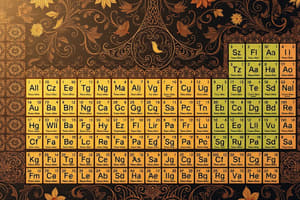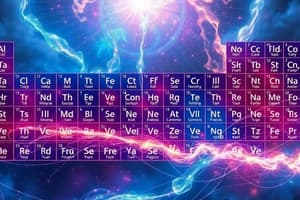Podcast
Questions and Answers
An element from Group 16 (chalcogens) is most likely to have how many valence electrons?
An element from Group 16 (chalcogens) is most likely to have how many valence electrons?
- 16
- 8
- 2
- 6 (correct)
Which electron configuration represents an element with 5 valence electrons?
Which electron configuration represents an element with 5 valence electrons?
- 1s² 2s² 2p⁶ 3s² 3p⁴
- 1s² 2s² 2p⁶ 3s² 3p⁶
- 1s² 2s² 2p⁶ 3s²
- 1s² 2s² 2p³ (correct)
Which of the following elements is most likely to form a stable ion with a charge of +1 by losing a valence electron?
Which of the following elements is most likely to form a stable ion with a charge of +1 by losing a valence electron?
- Chlorine
- Oxygen
- Sodium (correct)
- Nitrogen
Which element is an exception to the octet rule, achieving stability with only 2 valence electrons?
Which element is an exception to the octet rule, achieving stability with only 2 valence electrons?
How many valence electrons does an atom of carbon have?
How many valence electrons does an atom of carbon have?
Which of the following statements accurately describes the role of valence electrons in chemical bonding?
Which of the following statements accurately describes the role of valence electrons in chemical bonding?
Which element is most likely to gain two electrons to achieve a stable octet configuration?
Which element is most likely to gain two electrons to achieve a stable octet configuration?
What is the number of valence electrons in an element with the electron configuration 1s² 2s² 2p⁶ 3s² 3p⁵?
What is the number of valence electrons in an element with the electron configuration 1s² 2s² 2p⁶ 3s² 3p⁵?
How does understanding valence electrons help in predicting chemical reactions?
How does understanding valence electrons help in predicting chemical reactions?
Which statement accurately describes the trend of valence electrons across the periodic table?
Which statement accurately describes the trend of valence electrons across the periodic table?
Flashcards
Valence Electrons
Valence Electrons
Electrons in the outermost energy level (shell) of an atom, involved in chemical bonding.
Valence Electrons & Group Number
Valence Electrons & Group Number
For main group elements, it's the same as the group number on the periodic table.
Valence Electrons from Configuration
Valence Electrons from Configuration
Write the electron configuration and find the highest energy level (n). Sum the s and p electrons in that level.
Example: Sodium's Valence Electrons
Example: Sodium's Valence Electrons
Signup and view all the flashcards
Valence in Transition Metals
Valence in Transition Metals
Signup and view all the flashcards
Lewis Structures
Lewis Structures
Signup and view all the flashcards
Octet Rule
Octet Rule
Signup and view all the flashcards
Achieving Stability
Achieving Stability
Signup and view all the flashcards
Importance of Valence Electrons
Importance of Valence Electrons
Signup and view all the flashcards
Duet Rule
Duet Rule
Signup and view all the flashcards
Study Notes
- Valence electrons exist in the outermost shell (energy level) of an atom.
- These electrons facilitate chemical bonding.
- Valence electrons dictate an element's chemical properties.
Determining Valence Electrons
- An element's position on the periodic table reveals the quantity of valence electrons it possesses.
- For elements in the s-block and p-block (main group elements), the group number equals the number of valence electrons.
- Group 1 elements (alkali metals) contain one valence electron.
- Group 2 elements (alkaline earth metals) contain two valence electrons.
- Group 13 elements (boron group) contain three valence electrons.
- Group 14 elements (carbon group) contain four valence electrons.
- Group 15 elements (nitrogen group) contain five valence electrons.
- Group 16 elements (chalcogens) contain six valence electrons.
- Group 17 elements (halogens) contain seven valence electrons.
- Group 18 elements (noble gases) typically contain eight valence electrons, except for helium, which contains two.
Electron Configuration
- Determining valence electrons is also possible via the electron configuration of an element.
- First, write out the element's electron configuration.
- Then, identify the outermost energy level using the highest principal quantum number (n).
- Count the electrons present in the s and p sublevels of the outermost energy level.
- The sum represents the number of valence electrons.
Examples
- Sodium (Na) has an electron configuration of 1s² 2s² 2p⁶ 3s¹.
- Its outermost energy level is 3, containing one electron in the 3s sublevel.
- Sodium, therefore, has one valence electron.
- Oxygen (O) has an electron configuration of 1s² 2s² 2p⁴.
- The outermost energy level is 2, with two electrons in the 2s sublevel and four in the 2p sublevel.
- Consequently, oxygen has six valence electrons (2 + 4 = 6).
- Neon (Ne) has an electron configuration of 1s² 2s² 2p⁶.
- The outermost energy level is 2, containing two electrons in the 2s sublevel and six in the 2p sublevel.
- Thus, neon has eight valence electrons (2 + 6 = 8).
Exceptions
- Transition metals (d-block elements) and inner transition metals (f-block elements) can exhibit variable valencies.
- Their valence electron configurations are often more complex.
- For transition metals, the (n-1)d electrons may participate in bonding.
- This leads to multiple possible oxidation states for these elements.
Lewis Structures
- Valence electrons are depicted as dots in Lewis structures.
- The element's chemical symbol is written first.
- Dots representing valence electrons are placed around the symbol, first singly, then paired.
- This is useful for visualizing bonding in molecules.
Importance of Valence Electrons
- Valence electrons determine how atoms interact to form chemical bonds.
- Atoms gain, lose, or share valence electrons to achieve a stable electron configuration.
- A stable configuration usually means a full outermost shell, containing eight valence electrons (or two for elements like hydrogen).
- This is known as the octet rule (or duet rule for hydrogen).
- Understanding valence electrons is essential for predicting chemical reactions and properties of chemical compounds.
Studying That Suits You
Use AI to generate personalized quizzes and flashcards to suit your learning preferences.
Description
Valence electrons are the outermost electrons involved in chemical bonding and determine an element's chemical properties. The number of valence electrons corresponds to the element's group number in the periodic table. This rule applies to main group elements (s-block and p-block).




